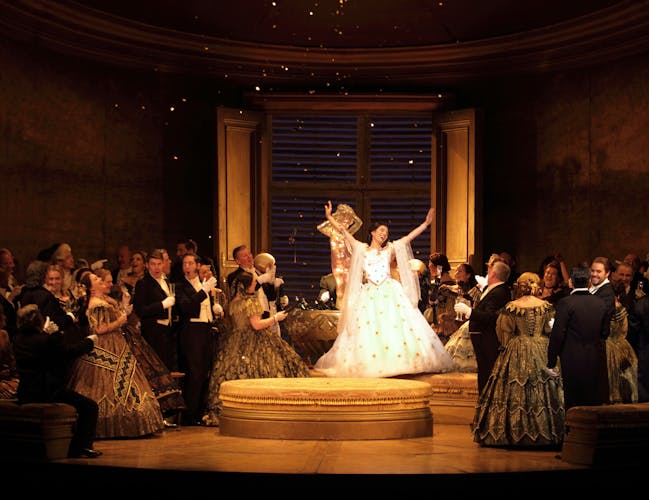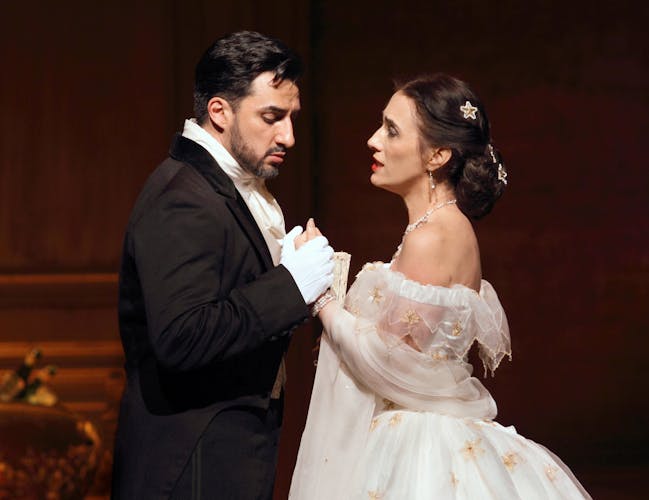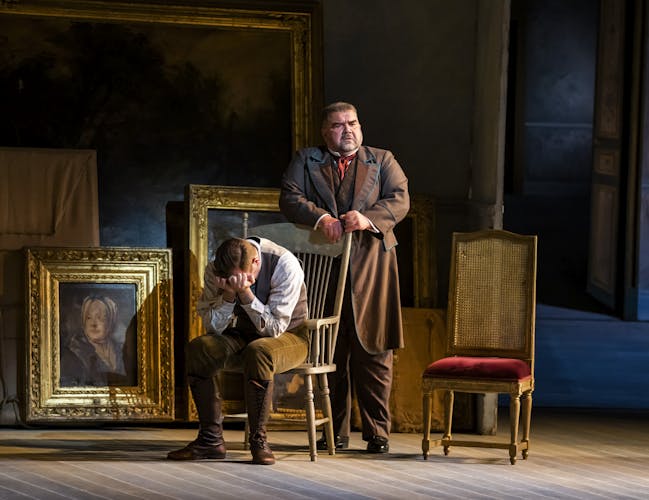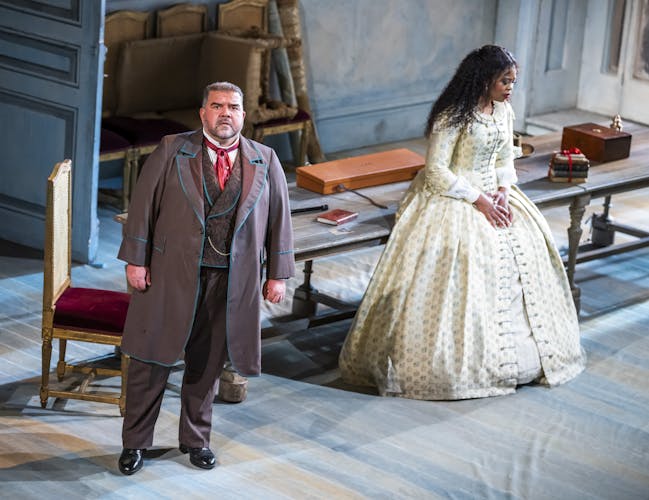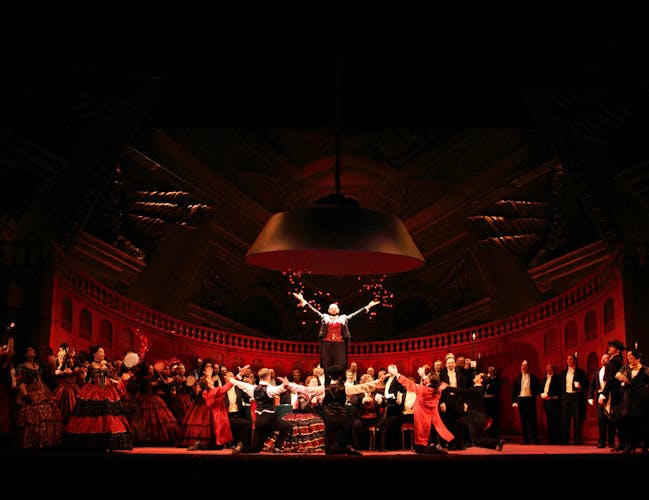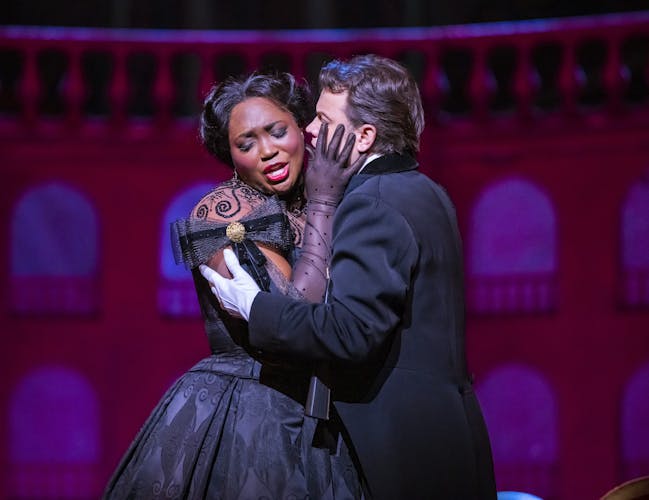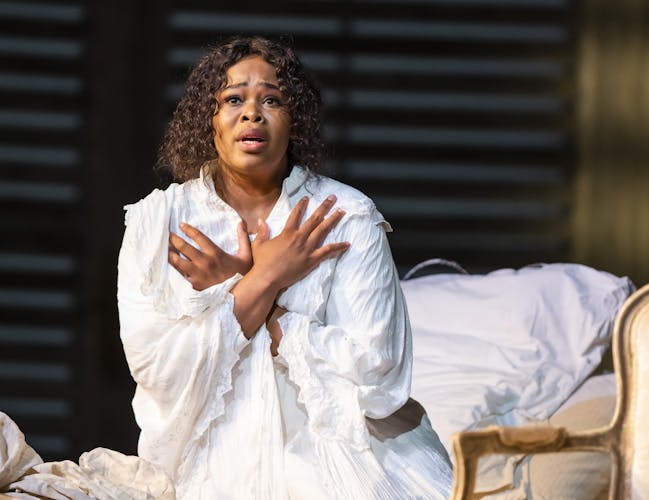La traviata
Our quick guide to Richard Eyre's lavish production of Verdi's opera of love and loss.
In La traviata, Verdi created one of his greatest characters. Violetta Valéry – the 'fallen woman' of the title – has won the hearts of audiences throughout the opera’s history.
Heart-rending arias meet harsh realities in this captivating story. Experience the devastating beauty of Verdi’s music in some of opera’s most famous tunes. This is the perfect opera to fall in love with for the first time, or over and over again.
Quick facts
What is La traviata about?
La traviata is about a woman – Violetta Valéry – who falls in love. Though hesitant to leave behind her life of luxury and freedom, she agrees, following her heart. But her way of life and her illness catch up with her, threatening to bring an end to this life she has chosen.
What does La traviata mean?
La traviata (literally: she who has strayed – tra – from the path - via) is inspired by the life and death of a real-life Parisian courtesan. It is often translated as 'the fallen woman', although the character of Violetta proudly attends many of Paris' most lavish parties.
Is La traviata based on a true story?
La traviata is based on the life and death of a young woman named Marie Duplessis (born Alphonsine Rose Plessis). She was the most fashionable courtesan in Paris in the 1840s and was the lover of Alexandre Dumas fils who's play about her life inspired the opera.
Is Pretty Woman based on La traviata?
Violetta’s story has inspired unforgettable scenes in films, from the musical, Priscilla, Queen of the Desert, to the film, Pretty Woman, in which Vivienne (played by Julia Roberts) is moved to tears by Verdi’s opera.
To find exclusive souvenirs and gifts inspired by Verdi’s opera: explore the La traviata collection at the Royal Ballet and Opera Shop.
History
Who is la traviata?
In January 1847, a young woman named Marie Duplessis (born Alphonsine Rose Plessis) lay dying of consumption at 11 Boulevard de la Madeleine in Paris. She had recently turned 23 and was the most fashionable courtesan in Paris, who serviced the city’s bourgeoisie, upper classes, artists, writers and musicians. Within a year of Duplessis’ death, Alexandre Dumas fils had written La Dame aux camélias. Dumas fils and Duplessis had been lovers for 11 months. The novel instantly took Paris by storm, not least because of its candid, unapologetic portrayal of forbidden pleasures and vices. On 2 February 1852, almost five years to the day since her death, Dumas’ dramatic adaptation of La Dame aux camélias received its premiere at the Vaudeville. It was almost certainly through this that Guiseppe Verdi and his companion, the singer Giuseppina Strepponi, first encountered the story.
Marie Duplessis has achieved lasting and universal fame as Violetta Valéry in the lyrics and music of Verdi’s opera. Proust claimed that La traviata transformed La Dame aux camélias into art. It also turned the tragic young woman from Normandy into a legend.
This is an edited extract from the works of René Weis. His works include the book The Real Traviata: The Song of Marie Duplessis.
La traviata Synopsis
- Violetta Valéry: a courtesan
- Alfredo Germont: a young bourgeois from a provincial family
- Giorgio Germont: Alfredo's father
- Flora Bervoix: Violetta's friend
- Baron Douphol: Violetta's lover, a rival of Alfredo
- Marquis d’Obigny: Flora's protector
- Doctor Grenvil: Gastone de Letorières and Alfredo's friend
- Annina: Violetta's maid
- Giuseppe: Violetta's servant
The elegant Parisian courtesan Violetta is hosting a party. Her friend Gastone introduces her to Alfredo Germont, and they drink a toast to love. As the guests go to dance, Violetta feels unwell. Alfredo offers her his protection and love. Violetta hands him a flower, telling him to return when it has faded. Alone, she wonders if she is in love at last.
Scene 1: A country house near Paris, the following January
Three months later, Alfredo and Violetta are living happily in the country. Alfredo goes to Paris to raise funds, and while he is away his father Giorgio visits Violetta. Giorgio Germont urges Violetta to leave his son – their affair is preventing Alfredo’s sister’s marriage. Heartbroken, Violetta agrees. When Alfredo returns, she begs him to always love her, then runs away. Alfredo hurries to Paris to find her.
Scene 2: A salon in Flora's house
Violetta’s friend Flora is hosting a party. Alfredo arrives, and wins much money at cards. Violetta enters with Baron Douphol. Alfredo manages to speak to Violetta alone, and asks her to return to him. When she refuses, he summons everyone and hurls his winnings at Violetta as payment for their time together. The Baron challenges Alfredo to a duel.
A month later, Alfredo returns to the now-dying Violetta. The couple are reunited and plan a new life away from Paris – but Violetta realizes she will not recover. Doctor Grenvil, Annina, Alfredo and the remorseful Giorgio Germont support her in her last moments. Violetta feels a sudden flood of life, but collapses dead in Alfredo’s arms.
Pictures and videos
Gallery
Cheers to that!
The champagne is flowing at the Parisian parties in Act I of La traviata. Brindisi is the Italian translation for 'a toast' but this musical highlight is often translated as 'The Drinking Song'. There is a cheerfulness throughout, of course, but also a hint of drama. In Alfredo's first verse he toasts to love: 'Libiam ne'dolci fremiti che suscita l'amore' (Let's drink to the sweet tremours aroused by love). Violetta, on the other hand, offers her toast to pleasure: 'Godiam, fugace e rapido, è il gaudio dell'amore' (Let us enjoy ourselves, for the delight of love is fleeting and quick). Although subtle, we see where their interests lie; Alfredo in pure love, while Violetta feels the pull of pleasure.
Love lives on
It is thanks to Violetta’s goodness, charm and most of all her likeableness that La traviata is one of Verdi’s most treasured operas – and one of his most heartbreaking. From the very opening of the opera we realize Violetta is sick. The party she throws in Act I is in part a celebration of her return to society after illness forced her away. Her first intimate encounter with Alfredo occurs when a sudden faint leaves her too weak to dance with her guests. But we, like Alfredo, are intoxicated by the brilliance of her singing, her witty rebuffs to his entreaties and her virtuoso aria ‘Sempre libera’ ('Always free').
Throughout Act III Verdi makes clear that something is wrong. Violetta’s first aria in the act, ‘Addio, del passato’ ('Farewell, dreams of the past') has an echo of her Act I fireworks, and pitiably spare accompaniment from pizzicato strings and a melancholy oboe. Violetta has desperately awaited Alfredo’s arrival. When he finally arrives they are both overcome with excitement, gabbling short phrases almost on top of each other, urgently reaffirming their love. The duet has a waltz-like rhythm, immediately signals its kinship with Violetta and Alfredo’s Act I duets, the Brindisi (drinking song) and ‘Un dì felice’ ('One happy day'). But this duet is softer, more tender. The short sighing phrases seem more like a lullaby than a dance, as Alfredo builds their dreams: ‘We’ll leave Paris… your health will come back, you will be the light of my life and the future will smile on us.’
Did you like the opera, dear?
Verdi's sublime score contains some of his most inspired arias and duets, including Violetta's introspective 'Ah fors'è lui' (‘Could it be him’) as she contemplates falling in love, before celebrating her independence in the spectacular ‘Sempre libera' (‘I must always be free’). We hear the latter aria in the film Pretty Woman as Vivienne (played by Juliet Roberts) is moved to tears at the opera. The Brindisi drinking song in Act I has also featured in adverts and flash mobs – memorably in a Heineken campaign, and in viral pop-up performances.
Watch more
Watch a performance
La traviata runs from 7–21 September 2024. There are many other ways to watch:
- Main Stage
La traviata
- Opera and Music
What would you sacrifice for the one you love?
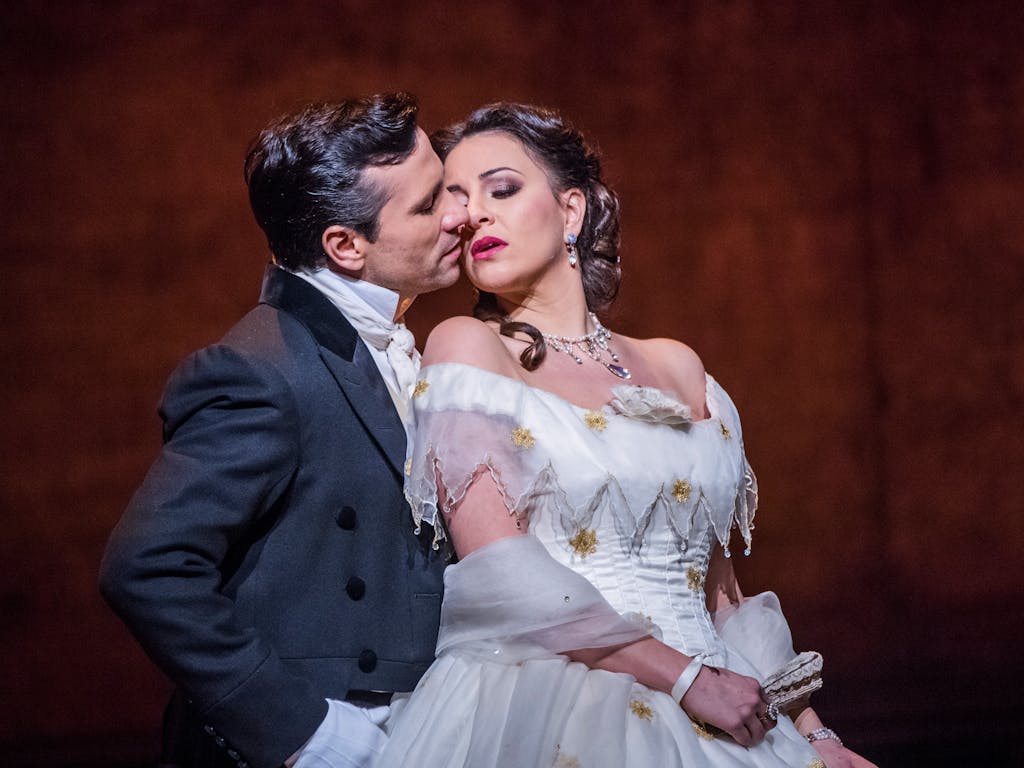
You can watch the production as well as behind-the-scenes insights, interviews and introductions on Royal Ballet and Opera Stream.
